|
:: ::
| I Viaggi Del Gusto UNDER THE TUSCAN SUN |
|
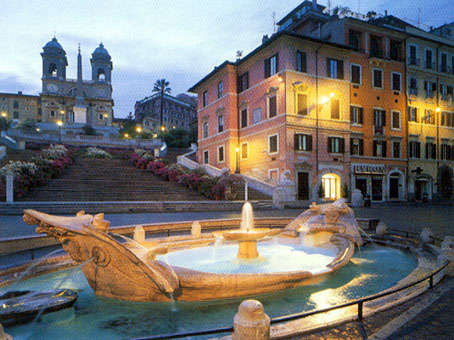 LAZIO HIGHLIGHTS LAZIO HIGHLIGHTS
- ROMA AND ITS JEWELS
- VATICAN AND THE SISTINA CHAPEL
- THE ROMAN VILLAS OF TIVOLI AND THE ROMAN CASTLES
- CINECITTA' : THE ITALIAN MOVIE STUDIO
|
LIST PRIVATE GUIDED TOURS : LAZIO AS YOU WANT
|
|
|
LAZIO OF DOLCE VITA: ETERNAL BEAUTY OF ROME AND HERITAGE OF AN EMPIRE
Do you like traveling to live become a myth?
You love to experience the magic you are looking for maximum satisfaction outside the tourist masses
.. FOLLOW YOUR WISHES and WE GUIDE YOU IN THE EXPERIENCE, THE ONE YOU CAN'T DO AND THAT WE DO ONLY FOR YOU !!!
|
CONTACT OUR EMOTIONS' SAILOR
|
VISIT LAZIO
|
|
_________________
VISIT LAZIO
_________________
ROME
EXPERIENCES
ROME AND THE VATICAN ETHERNAL BEAUTY [......]
_________________
VATICAN
San Pietro and Sistina Chapel
_________________
ROME
Colosseum, Imperial Forums and Pantheon
_________________
|
|
MAIN CITIES
ROMA THE CAPITAL
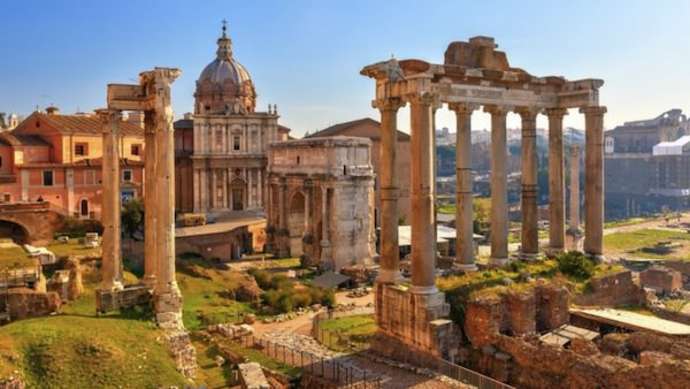
Since 1980 Rome’s Historic Centre, the extraterritorial buildings of the Holy See in the City and the Basilica of St. Paul Outside the Walls have been World Heritage sites. Other sites within the walls built by Urban VIII were added in 1990. Given the exceptional historical and cultural value of sites belonging to the Rome’s cultural patrimony, criteria for their evaluation and certification have been established with the help of HERITY. These criteria offer the public information on a site’s importance, conservation and accessibility in addition to encouraging the owners and/or managers to give due value and improved protection for the sites they are responsible for HERITY is the world organisation for the Certification of Quality Management of Cultural Heritage
CAMPIDOGLIO AND PIAZZA VENEZIA
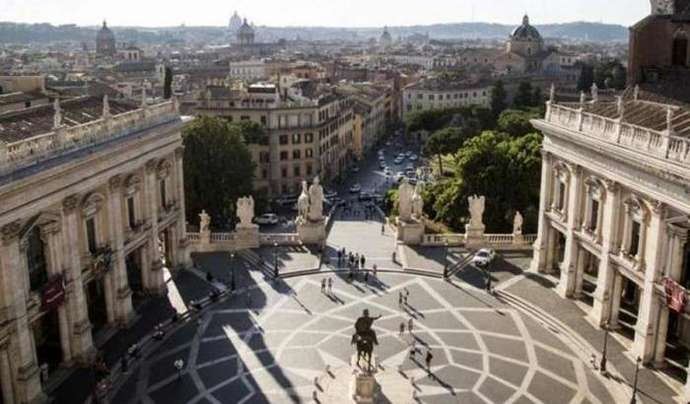
In antiquity, the Capitoline Hill represented Rome’s military, civil and religious sovereignty. It was a symbol of its magistracy. Its robust structure dominated the Tiber’s ford, rendering it able to maintain defences and as such, become the centre of privileged power. Its inhabitants made treaties, negotiated, dreamt, celebrated victories and pronounced and carried out sentences. The Capitoline is the lowest Roman hill.
The Campidoglio was progressively abandoned at the end of the ancient world, even to the point of losing its original name which was substituted by Monte Caprino. Over time, it enjoyed a renewal that culminated in its definitive rebirth during the 16th century with the systemisation by Michelangelo. His works significantly reversed the urban and monumental orientation of the hill by placing its back to the ancient, pagan Forum and facing the Pope’s new city
Piazza Venezia square owes its name to the palace that the cardinal of Venice, Pietro Barbo, who was later elected Pope under the name of Paul II (1464-71), built on the palace that at one time hosted the cardinals of San Marco. In ancient times, the piazza was called San Marco; however, when Pius IV conceded a portion of the Palace to the Most Serene Republic of Venice for their embassy, the piazza took its current name of Venezia. Piazza Venezia was the location of the finish line for the celebrated Corsa dei bàrberi, a horserace without jockeys. The current aspect of the piazza is the result of numerous demolitions performed between 1885 and 1911 in order to build the Monument to Vittorio Emanuele II. During the last century, the piazza became famous throughout the world for the assemblies held during the twenty-year Fascist period by Mussolini and his numerous speeches from the balcony of his office in the Palazzo di Venezia.Must The Capitoline Museums, Palazzo Venezia, The Vittorio Emanuela II Monument (Vittoriano), San Marco, Santa Maria in Aracoeli..
COLESSEO AND FORI IMPERIALI
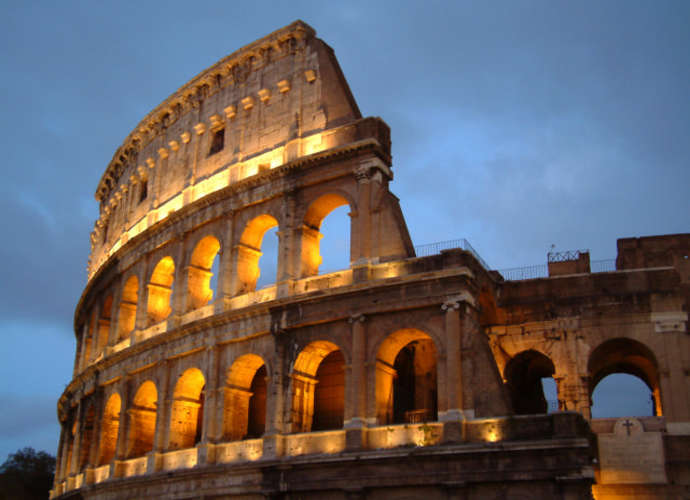
The valley where the Roman Forum came into existence was formed by the Tiber’s erosion of the sides of the volcanic lava from which the seven hills originated. Towards the end of the 6th century BC, under the Tarquin dynasty, the valley was reclaimed and the waters drained into the Tiber down a sewer, the Cloaca Maxima. As such, the area was now ready for use by the tribes who were already living on the surrounding hills, providing them with a place to meet, exchange goods and carry out the main activities of daily life. Thus, the Roman Forum was born, and became the centre stage of Roman history throughout the period of the Republic, right down to the 1st century AD.During Nero’s reign, the area currently occupied by the Colosseum constituted the fulcrum of his Domus Aurea complex. In particular, the area where the amphitheatre lies was previously an artificial lake that was reclaimed after the emperor’s death to construct the new, grand monument. The monument’s actual name is the Flavian Amphitheatre because it was built by the Emperor Flavius. Its current name, the Colosseum, is most likely in memory of the nearby colossal statue of the emperor Nero.At the end of the Republic period, the ancient Roman Forum was no longer able to perform all of its necessary functions,. By this time, Rome had become the centre of an true Empire and needed to increase its practical space. The most appropriate space for such purpose was identified as the area to the northwest of the former square.For centuries an intricate labyrinth of streets, shops and markets existed in this area. Julius Caesar was the first to intervene by creating the Forum of Caesar, which became the “prototype” for the Imperial Forums. Augustus followed Caesar’s example by adding another Forum perpendicular to the existing structures and penetrating deep into the heart of the Suburra. Then, it was Vespasian who created the grand complex to the south known as the Temple of Peace in order to celebrate his Judean conquest and it actually served as a public square.Between this complex and the preceding Forum of Augustus, there was a narrow space which Domitian used to create the so-called “Transitory Forum.” These forums were actually completed by his successor Nerva and took his name. When Trajan finally rose to power, the remaining area was deemed insufficient in size for his conquests. Thus, Trajan decided to excavate the area that joined the Campidoglio with the Quirinal Hill in order to create the space necessary to build the longest, largest and most spectacular of them all, the The Capitoline Museums, Palazzo Venezia, The Vittorio Emanuela II Monument (Vittoriano), San Marco, Santa Maria in Aracoeli..
FORO BOARIO AND PALATINO

The area of the Forum Boarium is of great interest due to its association with the city’s earliest beginnings, and even more important is the stretch of the Tiber now marked by the ruins of the 16th century Ponte Rotto. There is archaeological evidence of the formation of small settlements of hut-dwellers on the Palatine and on the other hills in the Tiber plain around 1000 BC. These united during the 8th century BC, giving rise to the city of Rome. The growth of these primitive settlements, inhabited by Latins, Sabines and Etruscans, was encouraged by the possibility of expanding trade along the river.Salt, a most precious commodity because of its use in rearing livestock and preserving meat, was panned at the mouth of the Tiber near Ostia and thence transported inland, along a route which was to become Via Salaria. However there was one principal factor which made vicinity to the river fundamental to the destinies of the groups living on the site of the Palatine and the other hills at the time and this was the ford located immediately downstream of the Tiber Island.Later replaced by the famous Pons Sublicius, this ford joined the two main routes crossed by livestock farmers - the route which led to the Etruscan North and that leading to the Greek South, later to become known as Via Aurelia and Via Appia, respectively.By controlling this stretch of the river close to the Tiber Island, the first Romans were able to benefit from the intense trade between the two areas and rapidly attained a position of prestige. It is no coincidence that the river bank overlooking this point was referred to as the Forum Boarium, or cattle market, right up to Imperial times.Must See: Santa Maria in Cosmedin, la Bocca della Verità (Mouth of Truth), l' Ara Massima di Ercole (Great Altar of Unconquered Hercules), il Tempio di Ercole Vincitore (The Temple of Hercules Victor), il Tempio di Portuno (Temple of Portunus), San Giorgio in Velabro, Circus Maximus, Palatine Hill, The House of Augustus.
AVENTINO HILL
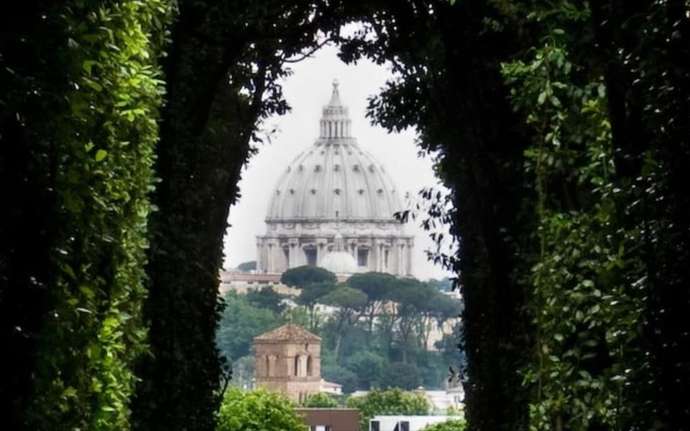
Among the seven hills of Rome, the Aventine could be considered the hill of poetry. Influenced by her peaceful beauty, great poets such as D’Annunzio and Carducci sang of her splendour in their verses. It was Mazzini, to whom a monument is dedicated in the piazza currently named after Ugo La Malfa, who while overlooking the city from that very place, lowered his eyes in an astonished gaze and stood without smiling in front of such magnificence. There are numerous interpretations for the origins of the name Aventine. Some says it was taken from the aves, the birds which were placed on the hill by Remus during the challenge with his brother Romulus to decide who should rule.Others believe that it comes from the term adventus, gatherings that were held by the plebs in celebration of goddess Diana.Moreover, there is an ancient legend that states that the king of Albalonga, Aventinus, was buried here after being having been killed by lightning. During the Monarchy and the Republic, the Aventine was the plebeian neighbourhood of Rome. In 451 BC, the plebs retreated in arms on the Aventine after the umpteenth abuse of power by the Decemviri, as led by Appius Claudius, who was elected to draft the Twelve Tables (the basis of Roman law) and quickly transform them into an oligarchy.The political crisis ended with the suicide of Appius Claudius, the obtainment of the rights requested and the return of the plebs to the city. The Aventine was also the location of the extreme actions of Caius Gracchus and his supporters.In modern times, Italian congressmen who refused to return to the halls of Montecitorio in 1924 as a protest against Matteotti were called “aventiniani.”Between the Republic and the Empire, the Baths of Sura and Decius were built on the Aventine in place of the luxurious residences. Due to its luxury, it was the area of Rome that suffered the most from the plundering by the Goths of Alarico in 410 AD.After the siege, the Aventine depopulated and became so deserted that is was preferred by monks and religious persons as a place for monasteries or retreats. It remained solitary and suggestive until the end of the nineteenth century as is witnessed in the watercolours of Ettore Roesler Franz.During the course of the twentieth century, the Aventine was transformed into an exclusive residential neighbourhood where luxurious real estate is mixed with charming ancient buildings.Be sure not to miss: Santa Sabina, Santi Bonifacio e Alessio, Priorato di Malta (Villa Malta), Santa Prisca, the Piramide di Caio Cestio (Pyramid of Caius Cestius), and Monte Testaccio
CARACALLA AND THE ARCHEOLOGICAL AREA
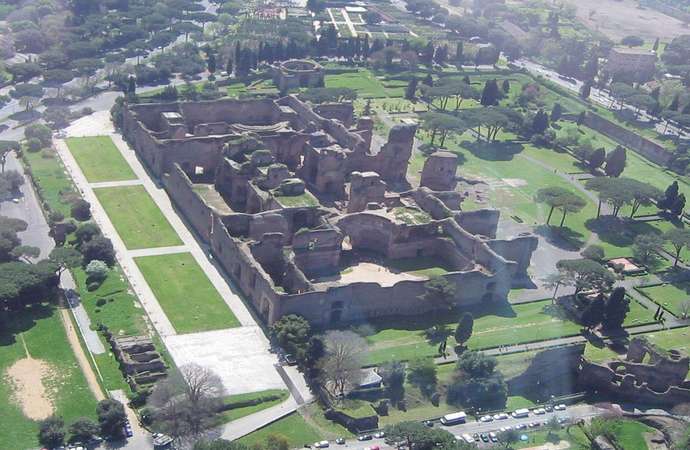
The area between Piazza Porta Capena and Piazzale Numa Pompilio represents the heart of a vast archaeological area that begins at the Roman Forum, passes Circus Maximus and the Baths of Caracalla and leads to Porta San Sebastiano and the Ancient Appian Way. The archaeological walking tour. The grand archaeological structures of the area are centred around the majestic ruins of the Baths of Caracalla (Terme di Caracalla). The boulevard which takes its name from the structure creates the principal axis for the so-called “Passeggiata Archeologica” (Archaeological Walking Tour) and this tour.The road, along with its continuation via di Porta San Sebastiano, follows the urban remains of the Appian Way. The Appian Way had its origins at the ancient Porta Capena of the so-called Servian Wall and was flanked by many sepulchre, which are still visible today.After the end of the Imperial age, some important convents such as Santa Maria in Tempulo, San Sisto Vecchio, Santi Nereo e Achilleo and San Cesareo were built along this road. These structures often performed the task of welcoming pilgrims from the southern regions of the peninsula.During Medieval times, it was these centres that maintained life, although somewhat in a state of neglect, on this extreme border of the urban expanse located within the Aurelian Wall.Beginning with the Renaissance period and continuing with the important archaeological findings implemented at the Baths of Caracalla, the area began a slow progressive recovery.After the unification of Italy, interventions were aimed at protecting ancient monuments that were threatened by the sudden and massive urbanisation in the surrounding neighbourhoods of Testaccio and San Giovanni.With the twenty-year Fascist period, the dream of making this area a large archaeological park faded and the grand streets built solely for pedestrian use became great flowing arteries for city traffic towards the new EUR neighbourhood.Be sure not to miss: Santa Balbina, the Terme di Caracalla (Baths of Caracalla), Santi Nereo e Achilleo, and the Mura (the Wall)
CAELIAN HILL
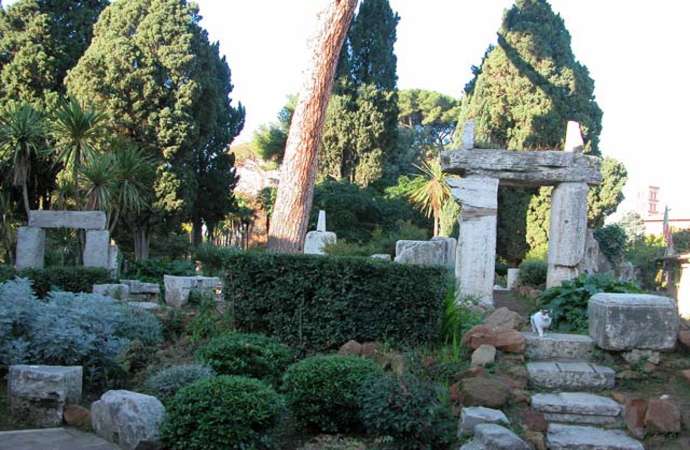
In ancient times, the Caelian Hill was completely covIn ancient times, the Caelian Hill was completely covered in oak trees and was called mons Querquetulanus. Later, it derived its current name from Celius Vibenna, the Etruscan leader. During the Augustan Age, the hill became the second regio or district of the city, but the fire of 64 AD destroyed the urban fabric of the area, which was then largely claimed by Nero.During the Flavian dynasty, the Colosseum as well as service structures for the events held at the amphitheatre were built at the foot of the hill. The area became more densely developed with magnificent luxury buildings and Septimius Severusrestored Nero’s aqueducts, the remaining arches of which currently characterise the area.The wealthy residences on the Caelian suffered immense damage during plundering by the Goths of Alarico, which took place from 24 to 27 August 410. The devastated lands were later acquired by the Church to build sanctuaries, convents and hospices, which used the pagan remains for their foundations.During the 6th century, the grand San Gregorio convent was built, whereas the diaconate of Santa Maria in Domnica and the Santi Quattro Coronati church were both built during the 9th century.With the devastating fire of 1084, caused by the invasion of Robert Guiscard, the religious and devotional structures located on the hill and its surroundings suffered immensely.The area only began to experience a revival with the construction of noble villas and numerous vineyards at the beginning of the 16th century. One of the most outstanding villas, currently known as Villa Celimontana, belonged to the Mattei family.However, it was during the 1950s that the monastic complex of Santi Giovanni e Paolo al Celio (St. John and St. Paul on Caelian) and the adjacent Romanesque bell tower were restored.Be sure not to miss: San Clemente, Santi Quattro Coronati, Santo Stefano Rotondo, Santa Maria in Domenica, Santi Giovanni e Paolo al Celio (St. John and St. Paul on Caelian), and San Gregorio al Celio (San Gregorio Magno).
SAN GIOVANNI IN LATERANO AND SANTA CROCE IN GERUSALEMME
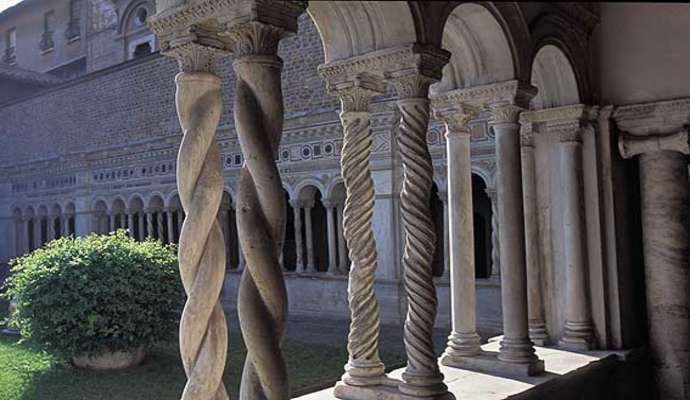
The Laterano complex has been one of the most significant and central locations in the history of Rome and the Church ever since 313 AD when Constantine assured religious freedom to the Christians of the Empire with the Edict of Milan.Today, the area is divided into two large squares. The first is Piazza San. Giovanni in Laterano, which is located at the back of the basilica and has the large Lateran Obelisk as its fulcrum, and the second, is Piazza Porta Giovanni, on which the grand eighteenth-century façade of the basilica stands.
In our day, due to a strange twist of fate, the square, which is so full of sacred sites, has become a sort of “secular gathering point” for the city.It was the funeral site for communist leaders Togliatti and Berlinguer and periodically welcomes the representatives of major national unions for speeches as well as oceans of spectators who gather for huge concerts held annually on 1 May.Be sure not to miss: San Giovanni in Laterano, Santa Croce in Gerusalemme, Scala Santa (Holy Stairs), Battistero Lateranense (Lateran Baptistery), and the Museo Nazionale degli Strumenti Musicali (National Museum of Musical Instruments).Be sure not to miss: San Giovanni in Laterano, Santa Croce in Gerusalemme, Scala Santa (Holy Stairs), Battistero Lateranense (Lateran Baptistery), and the Museo Nazionale degli Strumenti Musicali (National Museum of Musical Instruments).
LA SUBURRA AND TRINITA' DEI MONTI
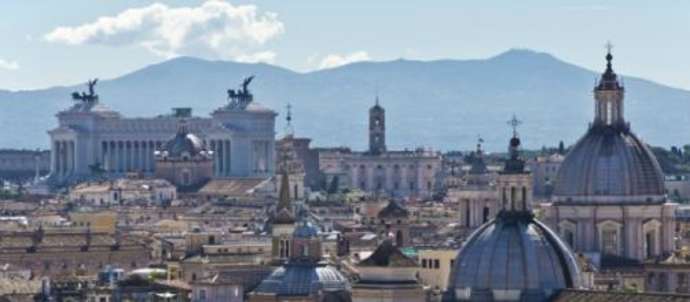
The Suburra, a term which has the same origin as the Latin suburbium was the most populated part of ancient Rome. It was the area below the city, outside it or rather outside of the original area allocated on the Eternal City’s Palatine Hill for nobility.The area was a labyrinth of alleys, shops, markets, hovels and insulae - multi-storey buildings with rented apartments.Actors, gladiators and courtesans lived in the Suburra. The most ill-famed of places such as taverns and dark alleys were also located there, providing ideal theatres for crimes and mischief. Numerous plebeian families lived in the area, which exhibited all of the human and social problems of the Emperor’s capital.According to slanderous ancient historiography, the alleys were frequented by famous personalities such as Nero, who strolled them incognito, and Messalina, who would leave the Imperial palace during the night in search of amorous adventures.Nonetheless, the Suburra was not just a place of doubtful reputation. Although it did not have any important monuments or public buildings, it was rich in popular devotional sanctuaries such as the temple dedicated to Juno, patroness of women in labour. Furthermore, it was the birthplace of the very noble Julius Caesar.The Suburra had an openly popular undertone. While its characteristics for the most part still survive today, at the same time, it is currently known as one of the most innovative areas of the city, fervent with cultural initiatives and brimming with night spots, shops and restaurants.In this neighbourhood, be sure not to miss: the Madonna dei Monti (Santa Maria ai Monti), Santa Pudenziana, Santa Prassede, and Santa Maria Mayre (Saint Mary Major)..
VIA VENETO AND LUXURY VIA CONDOTTI
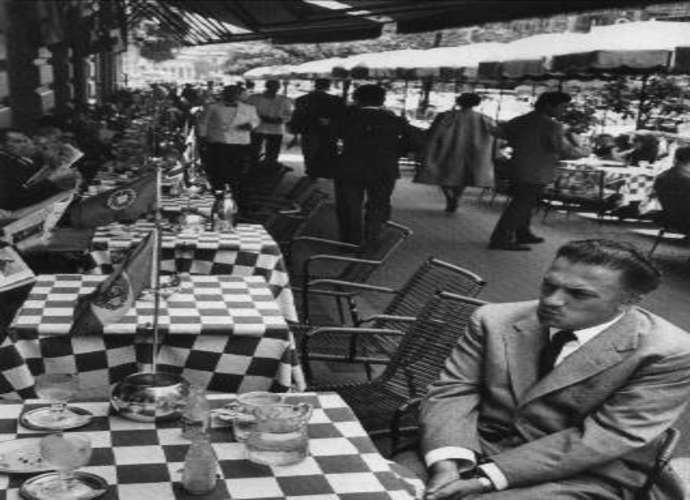
Via Veneto as well as Via Condotti are the most exclusive places to shop in Rome. They are both connected to the Spanish stairs and are really wonderful if you have really deep pockets. For people on a budget I would try the Corso which is close by. They are all close to Fontana di Trevi, the Pantheon, Piazza Venzia and basically right in the center of the city, you can't miss them. BTW despite common believe even in the most touristy areas you can still find deals on shirts, shoes and other clothes
APPIAN WAY
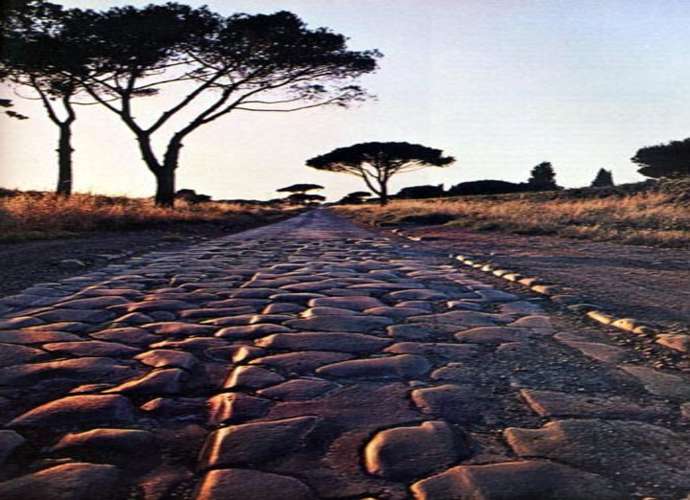
The Appian Way is one of the best preserved roman roads today.
The road was opened in 312 BC by the censor Appius Claudius Caecus, who widened a pre-existing road that went as far as the hills of Albano. It soon became known as the regina viarum, - the queen of roads and in 191 BC, it was extended as far as Brindisi thus becoming the main gateway to Rome for commerce with the East.The road, which flanks the sea and was more distant from conflict zones, was faster and safer than via Latina and quickly assumed a military and strategic role.Almost immediately, the first tombs were erected along the roadway such as those of the Scipioni, Servilii, Metelli and Catalino families. This tradition was continued by the Christians who constructed some of their most important catacombs here.From the end of the 2nd century BC with the increased use of free standing funerary monuments, the road slowly assumed the aspect which it mainly preserves today – a roadway lined on both sides by almost uninterrupted sepulchre of various shapes that alternate between family tombs and collective burials sites known as columbarium.The roadway’s surface in the best preserved ancient tract is called basolato. The term takes its name from the ancient paving stones which are made from enormous blocks of volcanic basalt. With the fall of the Roman Empire, the road was abandoned and unused for a long period of time.Throughout the Middle Ages, it was used as a pilgrim's route both because of the catacombs, and because it led to Brindisi from where pilgrims embarked for the Holy Land.It was only during the Renascence that the road began its slow recovery which was largely due to the efforts of numerous archaeologists and enthusiasts. Their contributions as well as recent works have now restored the Ancient Appian Way to its former glory..
EUR AND TRASTEVERE
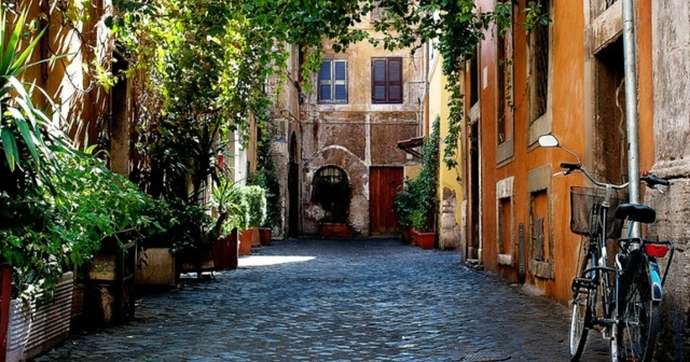
The EUR district of Rome was built in 1942 on the occasion of the Esposizione Universale which should have been held in the capital to celebrate the 20th anniversary of the Fascist March on Rome. EUR takes its name from the event. The area is famous for its particular architecture that draws on fascist ideology, classical Roman urban planning, elements of Italian Rationalism and the “simplified neoclassicism” proposed by Piacentini. The most symbolic element of this architectural model is the so-called "Square Colosseum," the nickname for the Palazzo della Civiltà Italiana (Palace of Italian Civilization) or the Palazzo della Civiltà del Lavoro. The building was designed by architects Guerrini, La Padula and Romano and inspired by metaphysical art.There are also many other examples of fascist architecture in the area such as the Palazzo dei Ricevimenti e dei Congressi (Congress Hall), Pietro e Paolo (the Church of Saints Peter and Paul) the obelisk named after Guglielmo Marconi, the Museo della Civiltà Romana (Museum of Roman Civilization), and the Museo Nazionale Preistorico Etnografico (Prehistoric Museum), among many others.The construction of the area was only completed at the end of the 1950s for the Rome Olympics held in 1960. At this time, numerous infrastructures were built such as the Palazzo dello Sport, the Cycling race track, the lake and adjacent areas.
Currently EUR, houses some public and private buildings, and is a well-served and lively residential area. Then TRASTEVERE A characteristic neighbourhood where the Roman folklore is still alive, where the laundry is still hanging from one window to another. And where the only Romans left in Rome live! Interesting to visit the beautiful church of Santa Maria in Trastevere, probably the first church dedicated to the Virgin Mary. It's facade is all glittering with ancient mosaics. Explore the cobbled streets and hidden alleys on Rome's left bank. And then to the Villa Farnesina: a magnificent suburban residence built in the 16th century for Agostino Chigi, the banker of the popes. In his garden he used to entertain cardinals, artists and men of letters. Inside the villa are paintings by the great Raffaello Sanzio. After the villa to cross the Tiber on the famous Sistine bridge from where it is possible to admire the cupolone (St. Peter's dome), andto walk along the historical via Giulia to Piazza Farnese all occupied by the imposing palace built for the Farnese family by Michelangelo and other architects.
OSTIA ANTICA
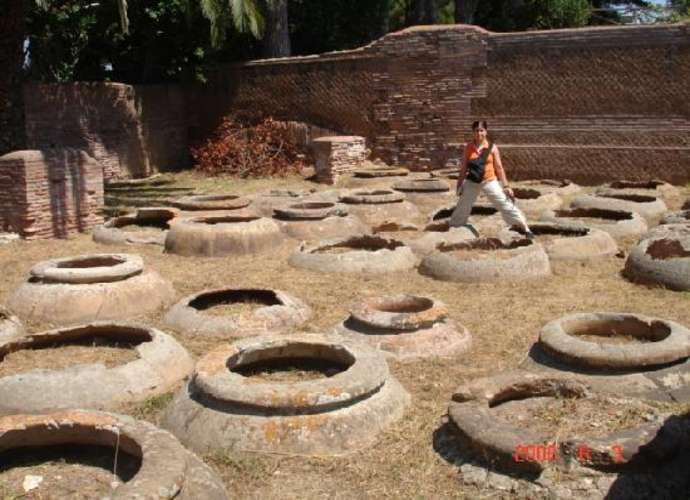
A trip to Rome would not be complete without a trip to the archaeological site of Ostia Antica. Upon arrival, visitors are immediately transported back to a typical ancient Roman city where the suggestive ruins of buildings from daily life have remained intact. Discover how and where people lived, shopped, worshipped, worked and entertained themselves. Ostia Antica is a truly unforgettable walk through history.
VATICAN
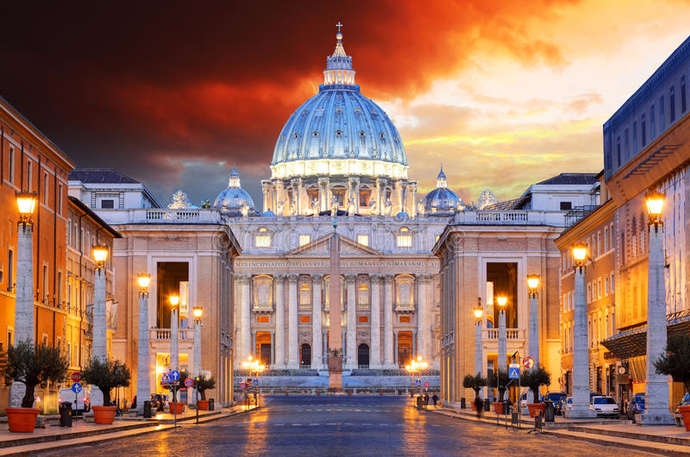
The Vatican City is the smallest independent sovereign state in the world with government, statutes and head of state of it's own. Although it covers just a few acres of land, it holds within its boundaries the residence of the Pope, the site of St Peter's Basilica, the Vatican Museums and the Sistine Chapel Saint Peter's Basilica Built in 1506 over St. Peter's tomb remains, Saint Peter's Basilica is the world largest Basilica.
In 1547 Michelangelo took over and simplified Bramante's previous plan, increasing the scale. At his death in 1954, one of Michelangelo's students, Giacomo della Porta, looked after the erection of the Dome following the master's design. Magnificent sculptures from Bernini, Michelangelo and many other great "Maestri" can be admired in the Basilica. Vatican Museums
The Vatican Museums comprise the papal apartments of the medieval apostolic Palace, frescoed during the Renaissance, the Sistine Chapel, the Vatican Apostolic Library, and the Museums themselves. The first actual Museums (the Pio-Clementine Museum, the Gallery of the Candelabra, the Chiaramonti Museum and the Inscription Gallery), devoted to classical Greco-Roman statuary, were founded by the popes of the 18th and 19th centuries and later enlarged in the 18th Century, with the construction of new buildings inspired by the Roman Imperial architecture. In the 19th century three other Museums were created by pope Gregory XVI :
the Etruscan Museum , which contains 18 rooms of Etruscan artifacts and Greek statuary
the Egyptian Museum, cointaining statues brough from Egypt in the imperial age
the Tapestry Gallery where tapestries by Raphael's school can be admired
In the 20th century, the Vatican collection was rearranged in the Pinacoteca, a new building set aside for the purpose.
Later on, in 1973, three other collections were arranged in the same building:
the Profane Gregorian Museum, containing classical statuary
the Pio-Christian Museum, containing works from the excavation of catacombs
the Missionary-Ethnological Museum, housing works from extra-European cultures
THE CASTELLI ROMANI
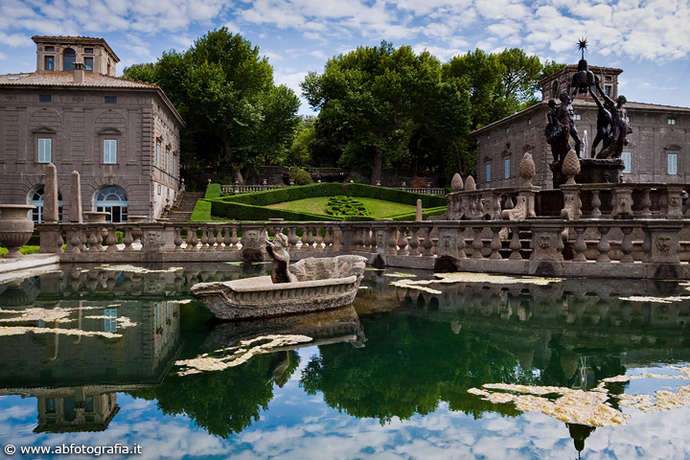
The name Castles derives from the villages that aroused around the Popes’ villas and the rich noble families palaces that, following an old tradition, chose these sites for their summer residences. With a jump in a remoter past, back to the middle ages, searching into an age whose episodes are still misterious, we can imagine to find in the region plenty of castles, strongholds of the most important families that had them set in strategic places, like pawns on a chessboard, so to control all southern Lazio and communications with the Reign of Naples. The authentic Roman Castles were then the same villages that rose around those castles, that through the centuries became autonomous. The name reminds of no longer exhisting castles, symbols of power of families in continuous struggles to get control of the area.Actually, the name Roman Castles referred originally to all the inhabited areas of the Ancient Districtus Urbis, an area of about 100 miles, reduced then to 40 miles, that surrounded Rome from North to South. After the unification of Italy, in the new maps of the region the name Roman Castles indicated only the area of the Albani and Laziali Hills, characterized by a peculiar geographical unity. In the Midlle Ages this area was inhabited for practical reasons: after the fall of the Roman Empire and the setting of the Popes in Avignon, Romans preferred to refuge around the secure castles of Princes. A sudden change occured when the Popes returned to Rome. Due to the humanistic love for antiquity, the attention of the erudites, starting with Pope Pius II member of the Piccolomini family, turned to the Vetus Latium, with its the solemn and impressive memories of the Roman history, that had left in these places huge civil and religious testimonies.The beauty of the area, still untouched, the purity of the air, moved both Popes and the high Roman society to build here their country villas, decorated by the same artists who were embellishing their Roman residences. The ways of the otium of these noble families, made of meetings, games, parties and adventures, followed the" French living-style " fashion while the Roman people came here for short journeys, for excursions to the country sides or to partecipate to popular and folkloristic festivals which are a big attraction even to modern visitors
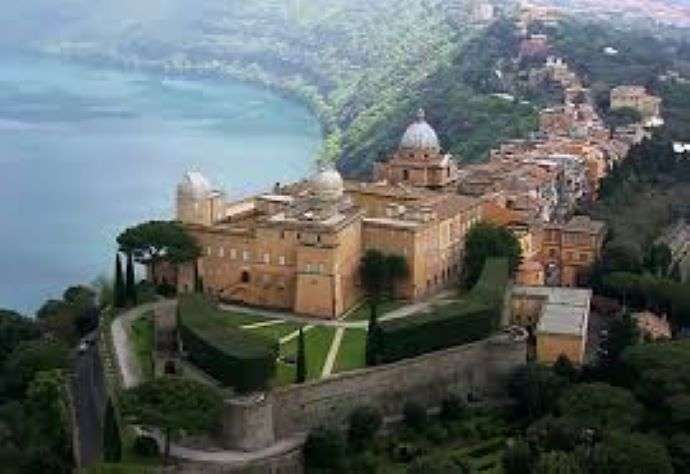
The beauty of the landscape, although menaced by modern and wild constructions, the quality of its air, its famous wine accompanied by tasty gastronomical specialties of the region, such as the porchetta served in the famous"fraschette" (cluster of little wine cellar), contributed to hide its artistical jewels behind thick and often impenetrable walls. And those places, loved and celebrated by painters and writers ever since, this same Roman countryside, picturesque and full of contrasts and history, so uselessly celebrated, because the words and the images of those who have preceded us have not prevented from wild deturpation, remain just a place of the mind, and only at times the ancient image returns alive to us, from the stillnes of a deep forest, from a limpid horizon, ruins noticed from car windows only because abandoned in the middle of a crossway. Noble imposing palaces, hidden behind town-walls, reveal themselves to the most curious and artistic eye, as old paintings they tell stories of gods and saints or sepulchres of important men. The invisibles Castles, are not at a glance, but they wait to be discovered
THE CIRCEO COASTLINE
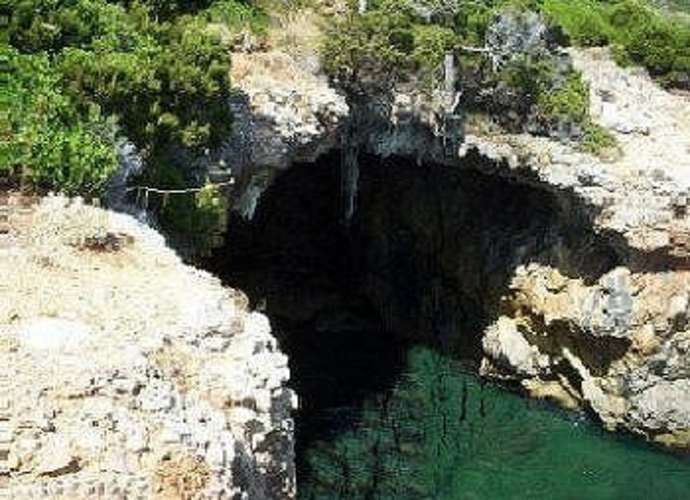
The Circeo National Park was set up in 1934 to safeguard a varied territory in which numerous habitats co-exist in a limited area. The high promontory of the Circeo is covered in Mediterranean rock vegetation, which grows densely down to the cliff, in which there are numerous grottoes inhabited by prehistoric man. The dunes begin near the Torre Paola and reach twenty-seven metres in height, at times covered in dense vegetation. Short wooden staircases protect the dunes and give access to the beach, where even in this hostile environment small plants such as the sea daffodil or the couch grass survive. A small beach extends from the harbour of San Felice del Circeo, beside the high promontory that characterises the landscape. A Saracen tower, visible from the harbour, stands out from the mountain. The Foresta di Circe is what remains of the ancient 'Selva di Terracina', composed of trees typical of the marine area, such as the maritime pine, the holm oak and the cork oak. We are in the largest natural forest of the Italian plains, inhabited by boars, badgers, hares, stoats and foxes. In the Circeo National Park there are the 'laghi pontini': stretches of coastal waters, the remains of the ancient marshes, the 'paludi pontine'. They are saltwater ponds rich with fauna: birds nest in the reed beds and in the canals we find the rare marsh turtle
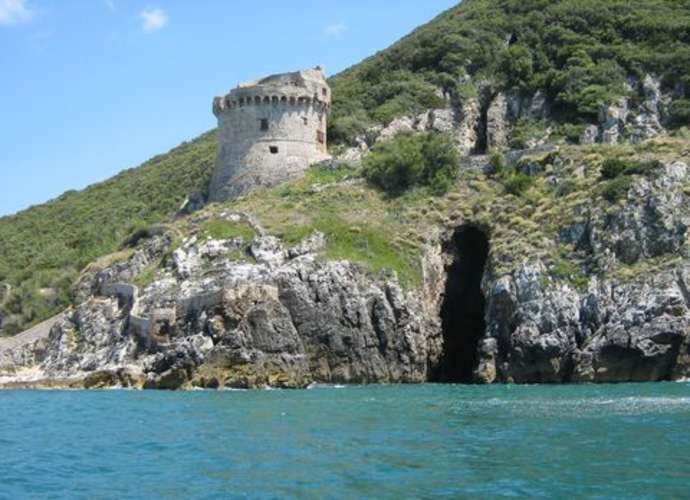
|